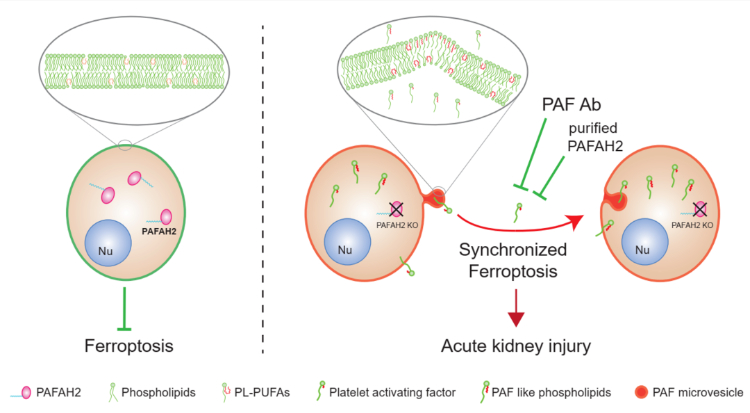NKU Team Discovers Mechanism by which Phospholipase PAFAH2 Suppresses Ferroptosis
Professor Chen Quan’s research group from the College of Life Sciences of Nankai University, Professor Xiong Wei’s research group from the University of Science and Technology of China, and Professor Wang Yong’s research group from the College of Life Sciences of Zhejiang University jointly published an online paper entitled “PAFAH2 suppresses synchronized ferroptosis to ameliorate acute kidney injury” in the journal Nature Chemical Biology. The paper reported on the transmission factors and regulatory mechanism of ferroptosis, and found that phospholipase PAFAH2 can suppress the platelet-activating factor (PAF) and PAF-like phospholipids (PAF-LPLs) mediated ferroptosis, thereby easing renal tubular injury caused by ischemia reperfusion.
This study found that exogenously supplemented PAF and oxidatively truncated phospholipids had significant cytotoxicity and exhibited typical ferroptosis characteristics. Lipidomics results showed that in the early stage of ferroptosis, PAF and oxidatively truncated phospholipids were produced profusely in cells and were secreted outside cells. All-atom molecular dynamics simulation and free energy calculations showed that as the concentration of PAF and its phospholipid analogues increases, the degree of defects on the surface of the cell membrane increased markedly, accompanied by increasing permeability of water molecules. It indicates that the destruction of this structure changed the control of the cell membrane over ion permeability, possibly triggering programmed cell death. Microinjection of PAF into culture cells or isolated primary renal tubules can promote cell death of neighboring cells or “wave-like cell death”, while neutralizing antibodies specifically bound to PAF can effectively suppress the occurrence of ferroptosis. These results indicate that PAF is an important molecule for cells to execute ferroptosis and promote the transition of ferroptosis in cell populations by secreting it extracellularly to infect neighboring cells.

PAF-acetylhydrolase (II) (PAFAH2) is an intracellular phospholipase that specifically hydrolyzes PAF and oxidizes truncated phospholipids (PAF-like phospholipids). Knockdown or knockout of PAFAH2 significantly increases the sensitivity of a variety of cells to ferroptosis and exacerbates acute kidney injury caused by ischemia-reperfusion in mice. In vivo in-situ imaging of mice showed that inhibition of PAFAH2 significantly increases synchronized renal tubular cell death due to ischemia-reperfusion, while intravenous injection of PAFAH2 exogenous recombinant protein significantly eases acute kidney injury caused by ischemia-reperfusion in mice. This study provides new therapeutic targets and strategies for renal ischemia-reperfusion injury.
Professor Chen Quan and Professor Li Yanjun from Nankai University, Professor Xiong Wei and Professor Zhu Hongying from the University of Science and Technology of China, and Professor Wang Yong from the College of Life Sciences of Zhejiang University are the co-corresponding authors of the paper, and Dr. Zhang Qianping and Dr. Sun Tiantian from Nankai University are the co-first authors.
Link: https://www.nature.com/articles/s41589-023-01528-7
(Edited and translated by Nankai News Team.)









